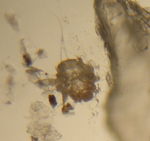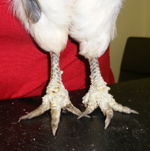Knemidocoptes
Knemidocoptes are burrowing mites of avian species. There are a number of important species infecting both production birds and pet animals.
Identification
Knemidocoptes are small round mites found in different locations on avian species dependant on the species of mite present. They have short legs similarly to most other species of burrowing mites. They may look similar to Sarcoptes spp. however they lack pegs and have dorsal striations instead. The mites breath through their cuticles and therefore are astigmata. The presence of a terminal anus can also be used as a distinguishing feature.
Detection
The method of detection is a combination of the presence of clinical signs as well as identification of mites on a skin scrape or feather pluck.
Life Cycle
The entire life cycle takes place on a single host and takes between 14 and 21 days to complete. The mite is spread by close contact with an infected animal, however it can survive for a limited time off the host.
Eggs
Laid into the stratum corneum by the burrowing female.
Larvae
Burrow into the skin and go through two nymphal stages before reaching maturity
Important Species
- K. mutans
- This species is the cause of 'scaly leg'in poultry species as the mite burrows beneath scales on the leg and foot. This causes lameness as well as the presence of ragged legs and feed and distorted claws.
- K. gallinae
- This species is a depluming itch mite in poultry. The mite burrows into feather shafts and causes pain and pruritus causing birds to pull out their own body feathers.
- K. pilae
- This species is the cause of 'scaly face' psittacine birds. The mite attacks the bare areas of the face, beak, cere and body causing scaliness but little pruritus.
Treatment
Treatment requires repeated use of acaricides however there are few of these products licensed for use in poultry

